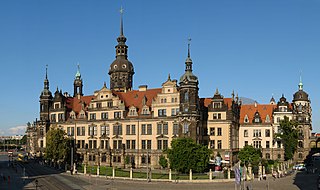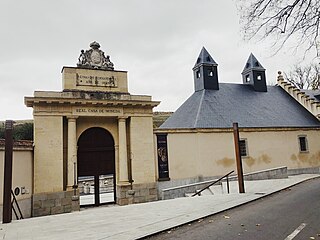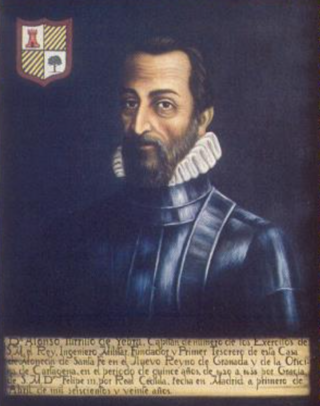
Tourism in Spain is a major contributor to national economic life, contributing to about 11.8% of Spain's GDP. Ever since the 1960s and 1970s, the country has been a popular destination for summer holidays, especially with large numbers of tourists from the United Kingdom, Ireland, Turkey, France, Germany, Italy, the Benelux, and the United States, among others. Accordingly, Spain's foreign tourist industry has grown into the second-biggest in the world.

The Museo Nacional Centro de Arte Reina Sofía is Spain's national museum of 20th-century art. The museum was officially inaugurated on September 10, 1992, and is named for Queen Sofía. It is located in Madrid, near the Atocha train and metro stations, at the southern end of the so-called Golden Triangle of Art.

The Museum of Gold is an archaeology museum located in Bogotá, Colombia. It is one of the most visited touristic highlights in the country. The museum receives around 500,000 tourists per year.

San Ángel is a colonia (neighborhood) located in the southwest of Mexico City in Álvaro Obregón borough. Historically it was a rural community called Tenanitla in the pre-Hispanic period. Its current name is derived from the El Carmen monastery school called San Ángel Mártir. It remained a rural community centered on the monastery until the 19th and 20th centuries when the monastery closed and the area joined the urban sprawl of Mexico City. The area still contains many historic buildings, and El Carmen is one of the most visited museums in the city. Its annual flower fair, Feria de las Flores , has been held since 1856.

The Museu Nacional d'Art de Catalunya, abbreviated as MNAC, is a museum of Catalan visual art located in Barcelona, Catalonia, Spain. Situated on Montjuïc hill at the end of Avinguda de la Reina Maria Cristina, near Pl Espanya, the museum is especially notable for its outstanding collection of romanesque church paintings, and for Catalan art and design from the late 19th and early 20th centuries, including modernisme and noucentisme. The museum is housed in the Palau Nacional, a huge, Italian-style building dating to 1929. The Palau Nacional, which has housed the Museu d'Art de Catalunya since 1934, was declared a national museum in 1990 under the Museums Law passed by the Catalan Government. That same year, a thorough renovation process was launched to refurbish the site, based on plans drawn up by the architects Gae Aulenti and Enric Steegmann, who were later joined in the undertaking by Josep Benedito. The Oval Hall was reopened for the 1992 Summer Olympic Games, and the various collections were installed and opened over the period from 1995 to 2004. The Museu Nacional d'Art de Catalunya was officially inaugurated on 16 December 2004. It is one of the largest museums in Spain.

La Casa de Moneda de México is the national mint of Mexico and is the oldest mint in the Americas.

Dresden Castle or Royal Palace is one of the oldest buildings in Dresden, Germany. For almost 400 years, it was the residence of the electors (1547–1806) and kings (1806–1918) of Saxony from the Albertine House of Wettin as well as Kings of Poland (1697–1763). It is known for the different architectural styles employed, from Baroque to Neo-renaissance.

The Museo Casa de Moneda is a numismatics museum located in La Candelaria neighborhood of Bogotá, Colombia. It is managed by the Bank of the Republic of Colombia and used to display its numismatic collection that is composed by around 18,600 objects that include artwork, banknotes, bonds, coins, derivatives, medals, negotiable instruments, and printing instruments from various periods and regions of the world.
Joaquín Rubio y Muñoz was a Spanish lawyer who was a noted antiquarian and numismatist in the city of Cádiz, Spain. He built up a library of manuscripts and rare books and in particular was known for his extensive collection of ancient coins and medals, many of which are now in museums in Spain and Denmark.

The Museo Nacional de las Culturas is a national museum in Mexico City dedicated to education about the world's cultures, both past and present. It is housed in a colonial-era building that used to be the mint for making coins. Prior to this, the site was the home of the location of the Moctezuma's Black House. The mint was moved to Apartado Street in 1850, and the building was used for various purposes until it was converted to its current use in 1966.

The Museo Soumaya is a private museum in Mexico City and a non-profit cultural institution with two museum buildings in Mexico City — Plaza Carso and Plaza Loreto. It has over 66,000 works from 30 centuries of art including sculptures from Pre-Hispanic Mesoamerica, 19th- and 20th-century Mexican art and an extensive repertoire of works by European old masters and masters of modern western art such as Auguste Rodin, Salvador Dalí, Bartolomé Esteban Murillo and Tintoretto. It is called one of the most complete collections of its kind.

The Royal Mint of Spain is the national mint of Spain. The FNMT-RCM is a public corporation that is attached to the Ministry of Economy.

The Museo Nacional de Artes Decorativas is located at 12 Montalbán Street, in Madrid, Spain, to the south of the Puerta de Alcalá and the western side of the Buen Retiro Park. It is one of the oldest museums in the city, situated within the Golden Triangle of Art. Following the example of the Victoria and Albert Museum in London, it illustrates the evolution of industrial or "minor arts", including furniture, ceramics, glass, and textiles. The collections emphasize the 16th and 17th centuries in particular; its collection contains approximately 70,000 pieces. Its 62 exhibition rooms are within a palace near the Jardines del Retiro de Madrid. The museum received 71,472 visitors in 2017.

The Coining House is a former royal mint in Segovia, Spain, which dates back to the 1500s. Today, it is a museum dedicated to coins, industrial heritage and Segovia's famous aqueduct.

The Pontevedra Museum is a museum in the Galician city of Pontevedra in Spain. It was founded by the Provincial Deputation of Pontevedra on 30 December 1927 and has six buildings for its exhibitions. It has permanent and temporary exhibition rooms. The museum's collections are multidisciplinary, classified into rooms for painting, sculpture, archaeology, decorative arts, engraving and ethnography.
The Casa de Moneda de Coquimbo was a mint created in La Serena, established on September 27, 1827, due to the silver mining boom triggered by the discovery of silver at Arqueros (1825). From the point of view of the Chilean government of that period, to purchase silver and make coins in the province of Coquimbo was more economical than transport the silver to Santiago.
The Numismatic Museum of Guatemala is a museum in Guatemala City. The museum is dedicated to the history of banknotes and coins used in the country.
The Classical Monetary System of the Oriental Republic of Uruguay includes the coins minted by the Oriental Republic of Uruguay between the years 1840 and 1855 in the national territory. These coins were minted entirely within the city of Montevideo, first at the "Taller y Armería Jouve" owned by a French artisan named Agustín Jouve and later at the Casa de Moneda de Montevideo or Casa de Moneda Nacional, which was created for this purpose.

Alonso Turrillo de Yebra was a Spanish military engineer and architect, at the service of the kings Felipe II, Felipe III and Felipe IV. Turrillo became the first royal treasurer of Madrid in 1607 and later arrived to the new Kingdom of Granada in 1621 with a royal order that accredited him to create the first Mint of Casa de la Moneda or Casa de Moneda is Spanish for mint (coin) in the New Kingdom of Granada. Turrillo became the first royal treasurer of Santafe de Bogotá.

















